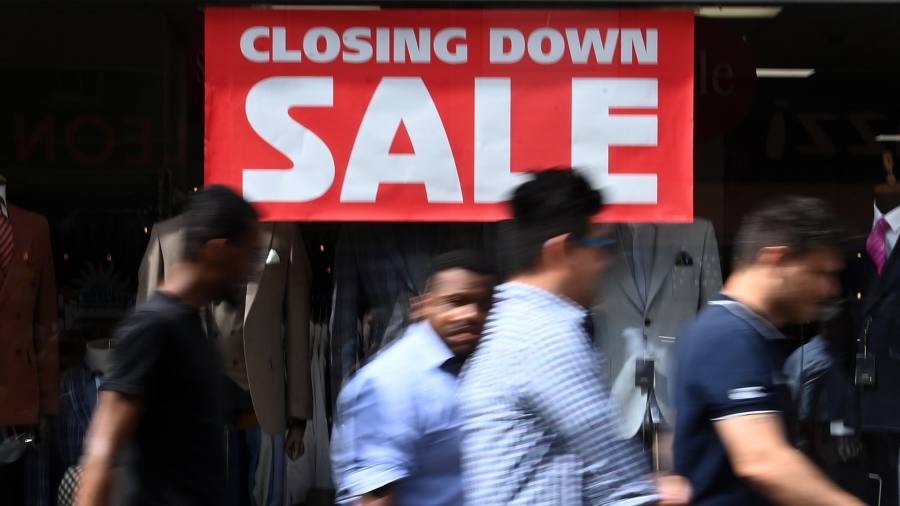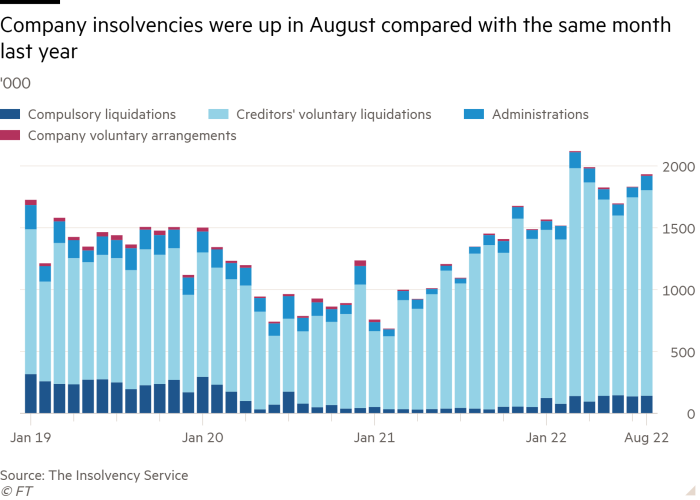
Corporate insolvencies rose sharply in England and Wales last month, according to official data published on Friday that highlight the effect of soaring costs, higher rates and weakening demand.
There were 1,933 registered company insolvencies in August, up 43 per cent from the same month last year and 42 per cent higher than in August 2019, before the pandemic.
Corporate insolvencies are formal measures taken when a company becomes unable to pay its debts.
The figures from the government’s Insolvency Service come as businesses are under growing pressure from a 20.5 per cent annual increase in the price of materials — a near-record high and soaring energy bills. Industry groups have warned these will lead to some companies collapsing.
Stacey Jones, partner at law firm BDB Pitmans, said the data reflected “spiralling inflation and interest, the energy crisis and the withdrawal of Covid-19 government support packages”.
She said the government’s £150bn package to limit energy costs would probably provide some respite for business customers and may avert the immediate threat of insolvency, but added: “It will be a sticking plaster.”

Jeremy Whiteson, partner in the restructuring and insolvency team at law firm Fladgate, said the data also reflected labour shortages, international shipping difficulties caused by Brexit and geopolitical uncertainty.
Most insolvencies were creditors’ voluntary liquidations, which rose to 1,662 in August, up 73 per cent from pre-pandemic levels and 33 per cent higher than in the same month last year.
Christina Fitzgerald, president of R3, the insolvency and restructuring trade body, said “this suggests that directors remain concerned about their ability to continue to trade in the current climate, and are choosing to close their businesses before that choice is taken away from them”.
Interest rates are expected to rise for the seventh consecutive time when the Bank of England’s Monetary Policy Committee meets next week. An increase would lead many households to tighten their belts and “directly affects businesses, particularly those in the retail, hospitality, construction and manufacturing sectors”, said Jones of BDB Pitmans.
As well as insolvencies rising, the economy stagnated in the three months to July, with faltering consumer demand reflected in the sharp August fall in retail sales, also revealed on Friday by the Office for National Statistics.
Apart from voluntary liquidations, other kinds of insolvency rose more sharply compared with 2021 but remained below pre-pandemic levels, reflecting state support for business during the Covid-19 pandemic.
The number of administrations, a procedure designed to allow businesses to restructure or be rescued, more than doubled compared with a year ago but was 34 per cent below August 2019 levels.
Compulsory liquidations were almost four times higher than in August last year but 27 per cent below pre-pandemic levels.
“These figures will be a sobering reminder to government of the scale of the challenge facing the UK economy as we head into the winter months,” said R3’s Fitzgerald.

